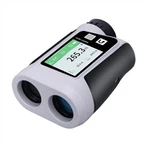Testing Tips for Analog Multimeters
Before testing a pointer type multimeter, first place the multimeter horizontally and check if its pointer is at zero (referring to the zero point of the current and voltage scales). If not, adjust the "mechanical zero adjustment" below the meter head to make the pointer point to zero. Correctly select the measurement items and range switches on the multimeter. If the measured order of magnitude is known, select the corresponding range of magnitude. If the order of magnitude of the measured value is unknown, the measurement should start with selecting a large range. When the pointer deflection angle is too small to read, the range should be reduced. Generally, the reasonable range is when the pointer deflection angle is not less than 20% of the * large scale.
Use of voltmeter
A multimeter should be connected in parallel to the circuit being tested. When measuring DC voltage, attention should be paid to the polarity of the voltage at the tested point, that is, connect the red probe to the high voltage end and the black probe to the low voltage end. If the polarity of the measured voltage is unknown, you can try using the probing method for measuring current mentioned above. If the pointer deviates to the right, you can proceed with the measurement; If the pointer deviates to the left, adjust the position of the red and black gauge pens before measuring. The internal resistance of the measuring circuit is very high, which requires a larger internal resistance of the voltmeter in order to achieve high measurement accuracy. At this point, it is necessary to use a multimeter with higher voltage sensitivity (greater internal resistance) for measurement. When measuring AC voltage, there is no need to consider polarity issues, as long as the multimeter is connected in parallel to the two ends being measured. In addition, it is generally not necessary to use a multimeter with a large range or high voltage sensitivity. The internal resistance of AC power supply is smaller than that of glue. It is worth noting that the measured AC voltage can only be a sine wave, and its frequency should be less than or equal to the allowable operating frequency of the multimeter, otherwise significant errors will occur. Do not toggle the range selection switch when measuring high voltages (such as 220V) to avoid arcing and burning out the contacts of the conversion switch. When measuring high voltage greater than or equal to 100V, it is necessary to first fix one probe to the common of the tested circuit and then use the other probe to touch the other testing point. If the range is not sufficient, it is necessary to switch to another gear to measure the volume frequency level. The multimeter is only suitable for measuring the volume frequency level. If there is a DC voltage on the circuit, a 0.1uF/450V capacitor must be connected in series to block the DC before measuring. When measuring the voltage in a circuit with inductive reactance, the multimeter must be disconnected before turning off the power after measurement. Otherwise, when cutting off the power supply, due to the self inductance phenomenon of the inductive components in the circuit, high voltage may be generated, which may burn out the multimeter.






